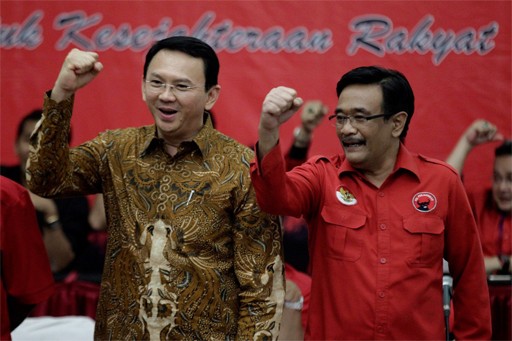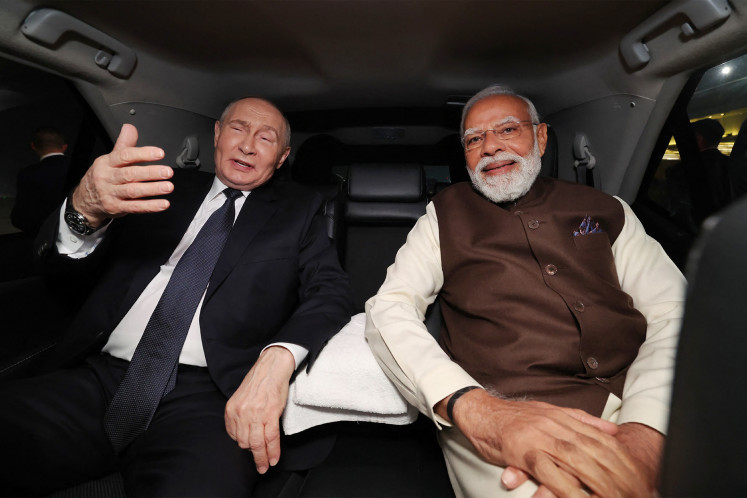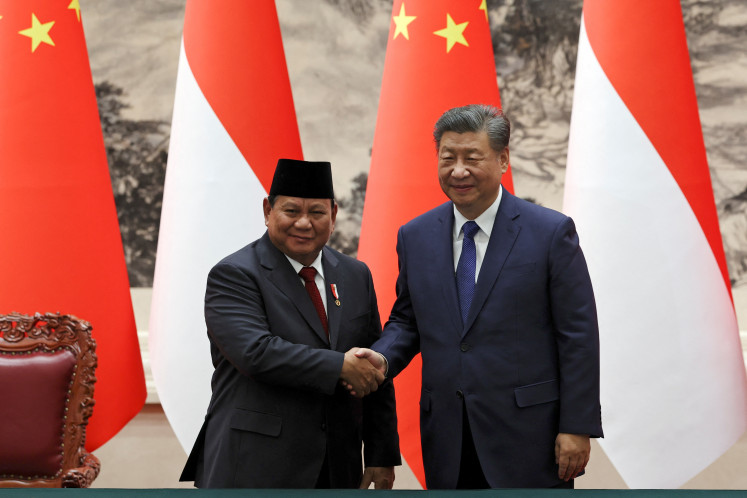Popular Reads
Top Results
Can't find what you're looking for?
View all search resultsPopular Reads
Top Results
Can't find what you're looking for?
View all search resultsJakarta’s battleground subdistricts in waiting
Change text size
Gift Premium Articles
to Anyone
I
n the Jakarta gubernatorial election next February, we will see three pairs competing: Basuki “Ahok” Tjahaja Purnama-Djarot Saiful Hidayat, Anies Baswedan-Sandiaga Uno and Agus Harimurti-Sylviana Murni.
These three are backed by the most powerful patrons in Indonesian politics. Ahok-Djarot is supported by former president Megawati Soekarnoputri, and apparently President Joko “Jokowi” Widodo. Anies-Sandiaga is backed by Prabowo Subianto, a major political figure and a candidate for president in 2014. Agus-Sylvana is the next iteration of former president Susilo Bambang Yudhoyono’s (SBY) political dynasty.
In this regard, the upcoming gubernatorial election is a rerun of the highly competitive 2014 presidential election, when Jokowi went head to head with Prabowo for the top job, while SBY fought for his political legacy after finishing his second term.
Jakarta is nationally strategic. It is a highly visible political platform and its electorate mimics the national sentiment. In 2014, the proportion of votes for both Jokowi-JK and Prabowo-Hatta in Jakarta was almost similar to the proportion nationally at 53 percent and 47 percent, respectively.
To get a sense of how the three camps will perform in Jakarta, it is useful to examine how the 2014 presidential election unfolded in the subdistricts of the capital’s five major districts. Looking at these subdistricts does not only give us a potential snapshot of the make-up of the whole electorate, but also, as Tip O’Neill — a legendary American politician — says, “All politics is local.”
Each of the subdistricts has particular characteristics that can shape their preferences in the election. Candidates must recognize this uniqueness and, importantly, propose ideas suited to these particular characteristics.
Although the 2014 election was only contested by two pairs, it can still provide a revealing reference point for the upcoming election. By assuming that Jokowi-JK voters are more likely to go for Ahok-Djarot, those who voted for Prabowo-Hatta will lean toward Anies-Sandiaga.
As for potential voters for Agus-Sylviana, an inference can be made from the performance of the Democratic Party — of which SBY is the patron — in Jakarta in 2009 and 2014. The party’s strength went from 32 seats in the Jakarta Legislative Council in 2009 to only 10 in 2014. Such a significant drop may present a steep climb for the pair to be competitive.
Looking back to 2014, Ahok-Djarot could have an advantage over its challengers, as Jokowi-JK won by about 6 percent (53-47 percent) in Jakarta. The pair can count on strong support from Jokowi’s bases in West and North Jakarta, and a healthy lead in Central Jakarta. Meanwhile, Anies-Sandiaga could build their voting block from Prabowo’s ground in East and South Jakarta.
The cornerstone of Ahok-Djarot’s support is in West Jakarta, which has the second-largest electorate with eight subdistricts. Within this district, the subdistricts of Grogol Petamburan, Taman Sari, Cengkareng, Tambora and Kali Deres could heavily favor Ahok-Djarot and even provide a margin of votes so large as to decide the election.
Only Palmerah in West Jakarta is competitive, while the other two subdistricts — Kebon Jeruk and Kembangan — could also favor Ahok-Djarot.
Ahok-Djarot can also expect major support from North Jakarta subdistricts. Penjaringan is the strongest with the potential for the pair to win almost three-quarter of votes. They can also expect support from around two-thirds of Pademangan and Kelapa Gading, with strong prospects in Tanjung Priok. Only in Koja and Cilincing might the other candidates make inroads, although the incumbent can still count on a slight advantage.
Ahok-Djarot has the potential to garner a large enough margin in these two districts, which could secure them another term in City Hall. North Jakarta and West Jakarta have higher population densities and more rooted communities — including the home of Jakarta’s Chinese Peranakan community — than other areas in the Capital. They are more receptive to the city improvement initiatives advanced by Jokowi when he was governor and now by Ahok-Djarot.
If Ahok-Djarot can repeat Jokowi-JK’s strong showing in these two adjacent districts, it will be difficult for the other candidates to catch up.
In Central Jakarta — the seat of the central government — Jokowi-JK’s strong showing in Gambir and Sawah Besar, as well as Kemayoran, could translate into a big margin for Ahok-Djarot. These three subdistricts have similar characteristics to those in North and West Jakarta as they are adjacent to them. Although the pair has a slight lead in Johar Baru and Senen, it is at a disadvantage in Menteng, Tanah Abang and Cempaka Putih. These latter three subdistricts could be competitive for the three candidates.
A different picture emerges from South Jakarta. Prabowo-Hatta in 2014 pulled a small lead in this district due to a hefty margin from Pancoran, Tebet, Mampang Prapatan and Jagakarsa. This perhaps was due to a rooted Muslim constituency in the four subdistricts that supported this pair. Two subdistricts in Setiabudi and Pesanggrahan are competitive, while Kebayoran Lama, Kebayoran Baru and Cilandak favored Jokowi-JK. These subdistricts are home to Jakarta’s middle-class crowd that heavily supported Jokowi-JK in 2014.
The strongest showing for Prabowo-Hatta in 2014 was in East Jakarta, where the pair came out ahead in nine of 10 subdistricts in the district. None of those wins, though, was decisive with a large margin. Despite East Jakarta being the largest electorate, the pair’s thin lead could not propel Prabowo-Hatta to an overall lead in Jakarta. The competitive nature of this district can be attributed to the diverse background of its residents who come from all corners of Indonesia
From these two districts, Anies-Sandiaga could build its constituency, and make an effort to deepen their support in East Jakarta. They could also begin to campaign harder in some subdistricts in South Jakarta where they could get traction with the middle class and millennials in the three districts that Jokowi won in 2014. Anies-Sandiaga also needs to expand its supporter base among members of these two demographic groups in other Jakarta districts.
Agus-Sylvana could chip away at Anies-Sandiaga’s numbers as the former’s likely supporters have comparable characteristics with those of the latter — urbane, intellectual, of the moneyed-class — which could resonate more deeply with Jakarta’s middle-class and millennials.
However, the biggest challenge is how to connect with people in the more working-class subdistricts in West, North and Central Jakarta: how to listen to their concerns and propose ideas and programs to better their lives.
Ahok-Djarot may be in the lead, but we look forward to seeing the other candidates fight for all and each of Jakarta’s subdistricts.
________________________________
The writers are political scientists and public affairs consultants at Kiroyan Partners. The views expressed are their own.










